Geothermal Water

Is geothermal energy a practical solution for colder climates ?
Geothermal energy is a renewable source of energy that comes from the heat generated by the Earth's core. It has been used for centuries in various forms, such as hot springs and geysers. In recent years, there has been an increasing interest in using geothermal energy as an alternative to fossil fuels. But is it a practical solution for colder climates? Let's explore this question further. Advantages of Geothermal Energy in Colder Climates: 1. Reliable Source of Energy: Unlike other renewable sources like solar or wind power, which are dependent on weather conditions, geothermal energy can be harnessed all year round, regardless of the temperature outside. This makes it an ideal source of energy for colder climates where there may be long periods of ice and snow. 2. Low Emissions: Compared to fossil fuels, geothermal power plants produce significantly fewer greenhouse gases and air pollutants. This makes it an environmentally friendly option for communities looking to reduce their carbon footprint. 3. Cost-Effectiveness: While the initial cost of setting up a geothermal power plant can be high, the long-term costs are relatively low compared to other sources of energy. Once established, geothermal power plants require little maintenance and have a lifespan of several decades. This makes it a cost-effective solution for colder climates where energy demands are high due to heating needs. Challenges of Geothermal Energy in Colder Climates: 1. Limited Availability: One of the main challenges of using geothermal energy in colder climates is its limited availability. Not all areas have access to geothermal resources, and even those that do may not have enough heat to generate significant amounts of energy. This means that while geothermal energy can be a practical solution for some areas, it may not be feasible for others. 2. High Initial Costs: As mentioned earlier, the initial cost of setting up a geothermal power plant can be high. This can be a barrier for communities with limited financial resources or those without access to government subsidies or grants. Additionally, drilling equipment and expertise may need to be imported from other countries, adding to the overall cost. 3. Environmental Impact: While geothermal energy is generally considered to be environmentally friendly, there are still some potential impacts associated with its use. For example, drilling activities can disturb wildlife habitats and disrupt local ecosystems. Additionally, if not managed properly, geothermal power plants can release harmful chemicals into the atmosphere or nearby water sources. Conclusion: In conclusion, geothermal energy can be a practical solution for colder climates under certain conditions. Its reliability, low emissions, and cost-effectiveness make it an attractive option for communities looking to reduce their reliance on fossil fuels. However, its limited availability, high initial costs, and potential environmental impacts must also be considered before making any decisions about implementing geothermal energy projects in colder climates.
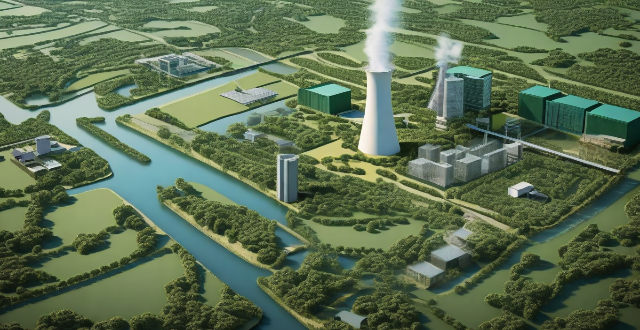
How does geothermal energy work and is it a viable alternative energy source ?
Geothermal energy is a renewable and sustainable source of energy that harnesses the natural heat from within the Earth's crust. This energy is obtained by drilling wells into the Earth's crust, where the heat is transferred to water or another fluid in a heat exchanger. The heated fluid then spins a turbine to generate electricity. There are three main types of geothermal power plants: dry steam, flash steam, and binary cycle. While geothermal energy has many benefits, including being renewable, cost-effective, and abundant in certain areas, it also comes with high upfront costs and location limitations. Additionally, there are environmental impacts associated with its use, such as potential contributions to earthquakes and impacts on local ecosystems. Despite these challenges, geothermal energy remains a valuable addition to our portfolio of renewable energy sources.

Can geothermal energy be a major source of power in colder climates ?
Geothermal energy, derived from the Earth's natural heat, can be a significant power source in colder climates. Key considerations include the availability of geothermal resources, technology and infrastructure, economic feasibility, environmental impact, and societal and regulatory factors. Challenges such as permafrost and public acceptance can be addressed through careful planning, technological innovation, and effective policy measures. If these factors are favorably aligned, geothermal energy could play a significant role in meeting the energy demands of colder regions while contributing to global efforts to combat climate change.

How does hydropower compare to other forms of alternative energy ?
Hydropower, a form of renewable energy that uses water flow or fall to generate electricity, is compared with other alternative energies like solar, wind, geothermal, and biomass across various aspects: 1. **Cost-Effectiveness**: Hydropower has high setup costs but low operational expenses, while solar and wind require significant upfront investment for installation but have lower running costs. Geothermal can be expensive initially due to drilling and exploration, and biomass costs vary based on the type and conversion technology used. 2. **Reliability and Consistency**: Hydropower offers consistent power generation as long as water flow is maintained. Solar power's reliability depends on sunlight, wind power on wind patterns, geothermal power provides consistent power once established, and biomass needs a steady supply of material for consistency. 3. **Environmental Impact**: Hydropower can impact habitats and water temperature but produces no direct emissions. Solar power has a relatively low environmental impact during operation but considers the manufacturing process. Wind power is generally environmentally friendly, geothermal power releases fewer pollutants than fossil fuels, and biomass burning releases CO2 but is carbon-neutral. 4. **Energy Storage and Grid Integration**: Hydropower offers excellent energy storage capabilities. Solar and wind powers require energy storage solutions. Geothermal power doesn't typically require energy storage, while biomass can be stored and used as needed. 5. **Scalability and Deployment Speed**: Large-scale hydropower projects can take many years to build, whereas small-scale or run-of-river systems can be deployed faster. Solar power can scale from small residential systems to large farms, and wind farms can be built relatively quickly. Geothermal power's scalability depends on the resource available, and deployment can be slow due to requirements. Biomass ranges from small community digesters to larger power plants, with scalability being moderate.

What are some innovative ways that people are using to generate their own alternative energy at home ?
The provided text discusses innovative ways to generate alternative energy at home. It mentions various methods such as solar power (solar panels, solar water heaters, solar chargers), wind power (home wind turbines, vertical axis wind turbines), hydropower (micro hydro systems, rainwater harvesting), geothermal energy (ground source heat pumps, geothermal water heaters), and biomass energy (wood burning stoves, biogas digesters). The conclusion highlights the potential of these methods in reducing a household's carbon footprint and contributing to a sustainable future.

What are some examples of recent technological advancements in renewable energy sources ?
Renewable energy sources have been gaining momentum in recent years due to the increasing awareness of climate change and the need for sustainable alternatives to fossil fuels. Here are some examples of recent technological advancements in this field: - Solar Energy: Perovskite solar cells, bifacial solar panels, concentrated solar power (CSP) systems with efficient heat transfer fluids and storage systems. - Wind Energy: Floating wind turbines designed for deep waters, smart grid integration with improved forecasting techniques, demand response programs, and energy storage solutions. - Hydropower: Run-of-river systems that minimize environmental impact by utilizing natural river flow, low head hydropower installed in existing water infrastructure without significant modifications. - Geothermal Energy: Enhanced geothermal systems (EGS) with improved drilling techniques and efficient heat exchangers, low-temperature geothermal heat pumps harnessing warmth from Earth's surface even in colder climates. - Biomass Energy: Anaerobic digestion process breaking down organic matter to produce biogas for electricity generation or as a natural gas substitute, torrefaction converting biomass into coal-like substance called biocoal with higher energy density and potential applications in replacing coal in power plants and industrial processes.

How does deforestation contribute to water cycle disruption ?
Deforestation contributes to water cycle disruption through soil erosion, surface runoff, and groundwater depletion. This leads to droughts, flooding, pollution, water scarcity, and climate change. Sustainable forest management is crucial to mitigate these effects.
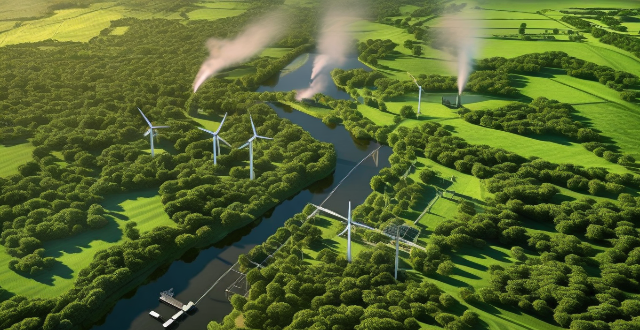
What are the most common types of renewable energy sources ?
Renewable energy sources are naturally replenished and provide a sustainable way to generate power without depleting the Earth's natural resources or contributing to climate change. Solar energy is harnessed through photovoltaic systems, solar water heaters, and concentrating solar power. Wind energy is captured by onshore and offshore wind turbines. Hydropower is generated through dam-based and run-of-river systems. Geothermal energy is tapped into via dry steam, flash steam, and binary cycle power plants. Bioenergy includes biomass combustion, anaerobic digestion, and biofuels. These sources offer clean alternatives to fossil fuels and play a crucial role in reducing greenhouse gas emissions.

How effective are large-scale water transfer projects in alleviating water scarcity ?
Water scarcity is a global issue, and large-scale water transfer projects aim to alleviate it by transporting water from areas with abundant resources to those with scarce ones. These projects can increase water availability, diversify water sources, and provide environmental benefits such as restoring depleted aquifers and wetlands. However, they also face challenges like high costs, negative environmental impacts, and social and political issues. To maximize the benefits of these projects while minimizing their drawbacks, careful consideration of their potential consequences and involvement of all relevant stakeholders in the decision-making process are essential.

How can we improve water resource management in our community ?
The article discusses the importance of water resource management in our community and suggests various strategies to improve it. These include raising awareness through educational campaigns, implementing water-saving measures like fixing leaks and using low-flow fixtures, upgrading infrastructure such as wastewater treatment plants, promoting sustainable practices like xeriscaping and green roofs, and fostering collaborative efforts among different stakeholders. By adopting these approaches, we can ensure the long-term availability of clean water while protecting the environment.
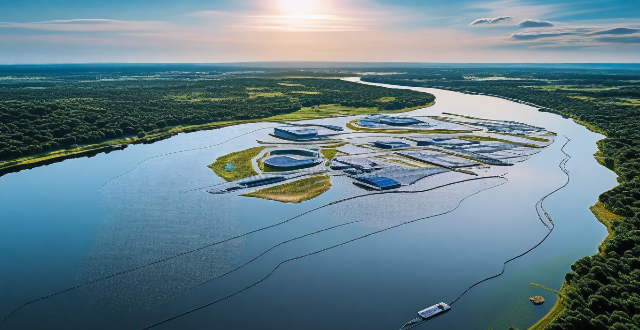
How does climate change affect water resources and availability ?
Climate change affects water resources and availability through melting glaciers, changes in precipitation patterns, sea level rise, increased evaporation rates, and impacts on ecosystems. These impacts can lead to water scarcity, flooding, contamination of freshwater sources, and declines in biodiversity. To mitigate these effects, it is important to reduce greenhouse gas emissions and implement adaptation strategies such as improved water management and conservation measures.

How can we balance economic development and water resource protection ?
Water resources are crucial for economic development but must be protected to ensure sustainability. Strategies for balancing these goals include prioritizing sustainable practices, implementing regulatory measures, fostering collaboration and partnerships, investing in infrastructure and technology, and educating and creating awareness. By adopting these approaches, we can achieve a balance between economic growth and water conservation, ensuring long-term sustainability for all.

What are some effective strategies for teaching water safety to children ?
Water safety is an essential skill that every child should learn, especially during the summer months when they are more likely to be around water. Here are some effective strategies for teaching water safety to children: Start early, set clear rules, use visual aids, practice makes perfect, role playing, stay close and supervised, teach risk assessment, and be a good example.

In what ways do dams and reservoirs affect downstream water ecosystems ?
Dams and reservoirs significantly alter downstream water ecosystems by changing water flow, trapping sediments, disrupting nutrient cycles, fragmenting habitats, and affecting biodiversity.

How can I reduce my electricity and water bills ?
To reduce electricity and water bills, one should switchTo reduce electricity and water bills, one should switch, adjust habits like turning off install water-saving fixtures, change bathroom habits, optimize garden watering, and be efficient with laundry and dishes.

How does climate change affect the quality and availability of drinking water ?
This article discusses the various ways in which climate change affects the quality and availability of drinking water, including changes in precipitation patterns, melting glaciers, sea level rise, temperature increase, extreme weather events, and wildfires. It also explores adaptation strategies such as water conservation measures, infrastructure improvements, protection of water sources, and policy and regulation to mitigate these risks and ensure a sustainable water future for all.
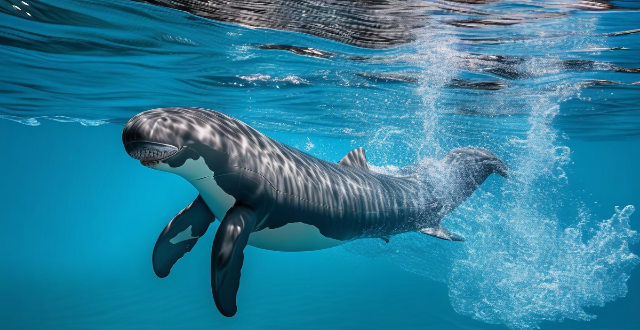
How do I overcome my fear of water and learn to swim ?
Overcoming a fear of water and learning to swim is a process that requires patience, persistence, and the right approach. Here's how you can do it: identify the source of your fear, gradually expose yourself to water, find a supportive instructor, start with basics in shallow water, progress slowly, use relaxation techniques, set realistic goals, celebrate small victories, join a swimming group or class, and always prioritize safety.

How does climate change impact water resource management ?
Climate change significantly impacts water resource management by altering precipitation patterns, increasing evaporation rates, and changing runoff patterns. These changes lead to more variable rainfall, prolonged droughts or intense flooding, reduced snowpack, and earlier spring runoff, among other effects. To adapt, strategies such as water conservation, infrastructure upgrades, integrated planning, ecosystem restoration, and improved monitoring and forecasting are essential for ensuring sustainable water resources amidst a changing climate.
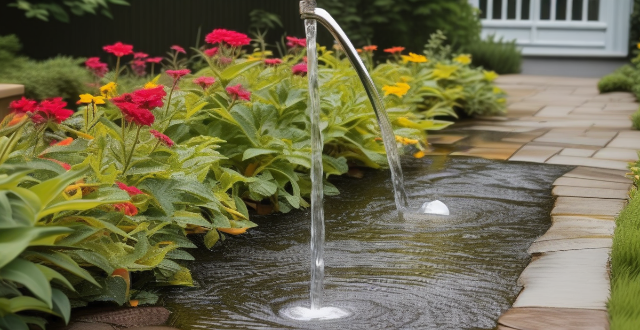
What are some tips for reducing water consumption at home ?
Reducing water consumption at home can be achieved through various methods, including fixing leaks, installing water-saving fixtures, using efficient appliances, changing habits, being smart with gardening, and monitoring usage. By checking for drips, tightening fixtures, upgrading to low-flow toilets and showerheads, using Energy Star washers and dishwashers, turning off the tap while brushing teeth or shaving, watering the garden in the morning, and regularly reading the water meter, households can save money on utility bills and contribute to a more sustainable environment.

Are AirPods waterproof or water-resistant ?
This text discusses the water resistance of Apple's AirPods, highlighting that the original and second-generation models have no official water resistance rating, whereas the AirPods Pro and third-generation models carry an IPX4 rating for water resistance. It explains the meaning of the IPX4 rating, offers safety precautions to protect AirPods from water damage, and concludes by emphasizing that AirPods are not completely waterproof.

How do I implement water conservation measures at home ?
Water conservation is crucial for sustaining the environment and ensuring future generations have access to clean water. Here's how you can implement water conservation measures in your home: identify areas of water consumption, repair leaks promptly, collect rainwater, educate family members, and regularly review your habits. By implementing these measures, you can significantly reduce your home's water usage and contribute to a more sustainable future for our planet.